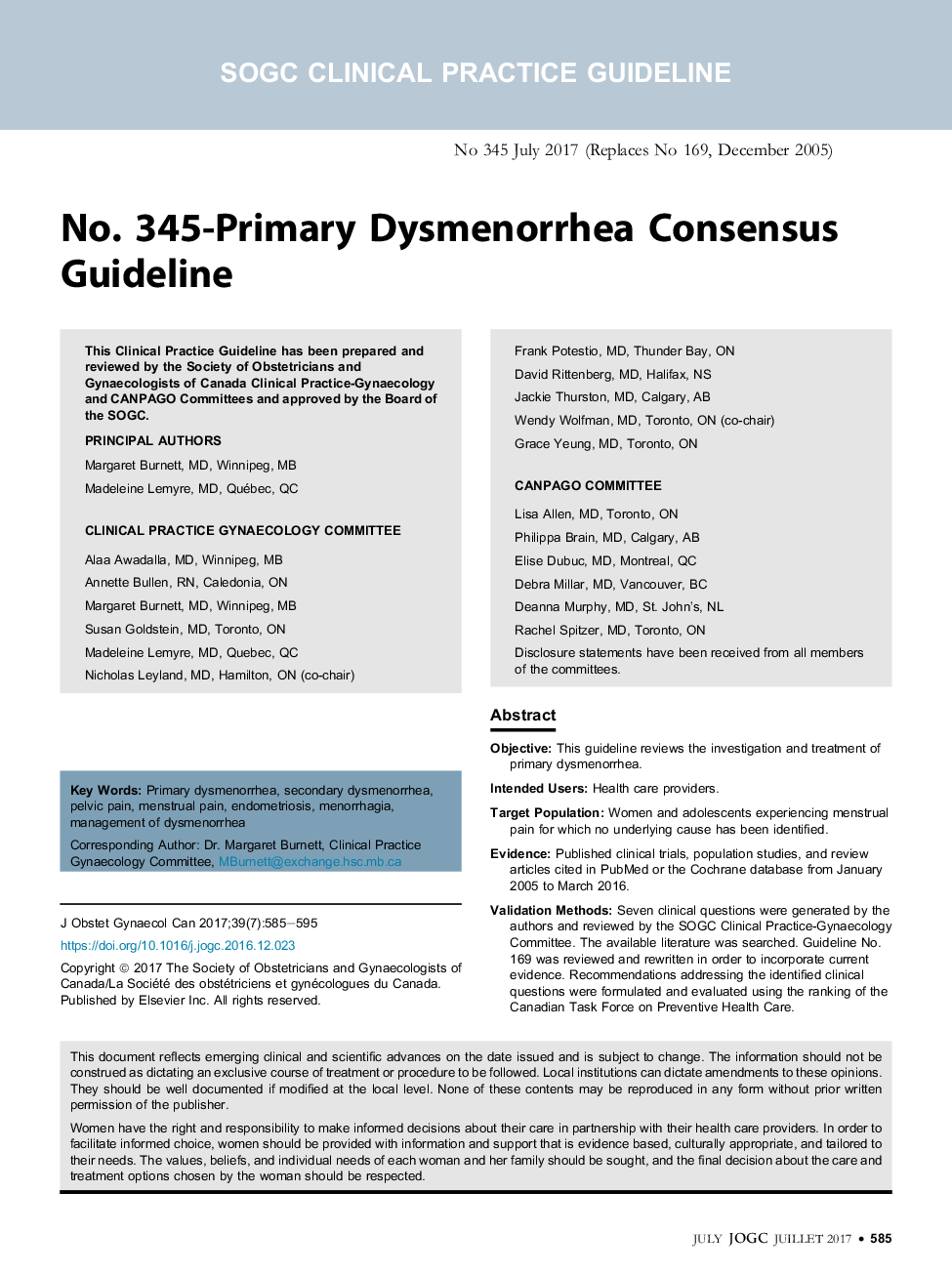| Article ID | Journal | Published Year | Pages | File Type |
|---|---|---|---|---|
| 5693230 | Journal of Obstetrics and Gynaecology Canada | 2017 | 11 Pages |
Abstract
ObjectiveThis guideline reviews the investigation and treatment of primary dysmenorrhea.Intended UsersHealth care providers.Target PopulationWomen and adolescents experiencing menstrual pain for which no underlying cause has been identified.EvidencePublished clinical trials, population studies, and review articles cited in PubMed or the Cochrane database from January 2005 to March 2016.Validation MethodsSeven clinical questions were generated by the authors and reviewed by the SOGC Clinical Practice-Gynaecology Committee. The available literature was searched. Guideline No. 169 was reviewed and rewritten in order to incorporate current evidence. Recommendations addressing the identified clinical questions were formulated and evaluated using the ranking of the Canadian Task Force on Preventive Health Care.Benefits, Harms, and CostsPrimary dysmenorrhea is common and frequently undertreated. Effective therapy is widely available at minimal cost. Treatment has the potential to improve quality of life and to decrease time lost from school or work.Guideline UpdateThis guideline is a revision and update of No. 169, December 2005.SponsorsSOGC.Summary Statements1.Dysmenorrhea is highly prevalent and commonly undertreated (III).2.Non-steroidal anti-inflammatory drugs are more effective than placebo but have more gastrointestinal side effects. All currently available non-steroidal anti-inflammatory drugs are of comparable efficacy and safety (I).3.Suppression of ovulation is associated with decreased menstrual pain (II-1).4.Amenorrhea induced by any means is beneficial for the treatment of dysmenorrhea (II-2).5.Hysterectomy is effective treatment (II-2).6.There is some evidence to support laparoscopic nerve ablation in selected cases (II-1).7.Endometrial ablation is likely to reduce symptoms of dysmenorrhea when it occurs in the presence of menorrhagia (I).Recommendations1.Both primary and secondary dysmenorrhea are likely to respond to the same medical therapy. Therefore, initiation of treatment should not depend on establishing a precise diagnosis (II-1A).2.Health care providers should include specific questions regarding menstrual pain when obtaining a woman's medical history (III-B).3.A pelvic examination is not necessary prior to initiating therapy (III-D).4.A pelvic examination is indicated in patients not responding to conventional therapy and when organic pathology is suspected (III-B).5.Non-steroidal anti-inflammatory drugs, administered with regular dosing regimens, should be considered first-line treatment for most women (I-A).6.Hormonal therapies should be offered to women and girls who are not currently planning pregnancy unless contraindications exist (I-A).7.Continuous or extended use combined hormonal contraceptives are recommended (I-A).8.Regular exercise is likely to improve symptoms of dysmenorrhea and should be recommended (II-1A).9.Local heat in the form of heated pads or patches should be recommended as a complementary treatment for dysmenorrhea (I-A).10.High-frequency transcutaneous electrical nerve stimulation should be considered as a complementary treatment or in women unable or unwilling to use conventional therapy (II-1B).11.Acupoint stimulation should be considered for women wishing to use complementary or alternative therapies (II-1B).12.Ginger is recommended for women wishing to use complementary or alternative therapies (I-A).13.Preoperative investigations should include a detailed history and physical examination, ultrasound, and possibly magnetic resonance imaging to discover secondary causes for dysmenorrhea and to direct appropriate therapy (III-A).14.Surgical intervention should only be considered if a concerted trial of medical therapy has not been successful (III-A).
Keywords
Related Topics
Health Sciences
Medicine and Dentistry
Obstetrics, Gynecology and Women's Health
Authors
Margaret (Principal Author), Madeleine (Principal Author),
